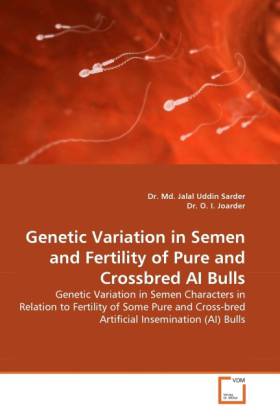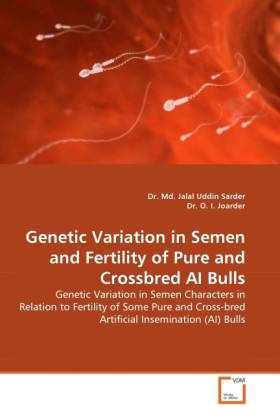
Je cadeautjes zeker op tijd in huis hebben voor de feestdagen? Kom langs in onze winkels en vind het perfecte geschenk!
- Afhalen na 1 uur in een winkel met voorraad
- Gratis thuislevering in België vanaf € 30
- Ruim aanbod met 7 miljoen producten
Je cadeautjes zeker op tijd in huis hebben voor de feestdagen? Kom langs in onze winkels en vind het perfecte geschenk!
- Afhalen na 1 uur in een winkel met voorraad
- Gratis thuislevering in België vanaf € 30
- Ruim aanbod met 7 miljoen producten
Zoeken
Genetic Variation in Semen and Fertility of Pure and Crossbred AI Bulls
Genetic Variation in Semen Characters in Relation to Fertility of Some Pure and Cross-bred Artificial Insemination (AI) Bulls
Jalal U. Sarder, O. I. Joarder
Paperback | Engels
€ 103,45
+ 206 punten
Omschrijving
The present investigation was to evaluate the genetic variation in semen characters in relation to fertility from 71 bulls used for Artificial Insemination (AI) programme. The bulls were classified as bull factors viz. breed, age, body weight, body condition, scrotal circumference and libido. Environmental and managemental factors were considered as season, ambient temperature and relative humidity during semen collection and AI stations. Friesian breed (100%) showed better phenotypic characteristics and 8-10 yrs of age groups gave superior performances. The largest volume obtained in 50%SL×50%F and smallest in 100%Local. Lowest and highest spermatozoa abnormalities were recorded to be in SL-499 and F-0054 respectively of AI station Dhaka. The significant highest sperm motility rate was recorded in 50%SL×50%F and lowest in 75%F×25%L bulls. The significant maximum NRR was recorded in genetic groups of 100%Local and minimum in 75%Friesian×25%Local. The highest TSL(71.65×1.6µ) was found in F-0064 and lowest (66.50×1.58µ) was in L-40275. Genotypes of progeny, sire and dam as well as grade of feed had significant effect on the reproductive and productive performances of female progeny.
Specificaties
Betrokkenen
- Auteur(s):
- Uitgeverij:
Inhoud
- Aantal bladzijden:
- 344
- Taal:
- Engels
Eigenschappen
- Productcode (EAN):
- 9783639306392
- Verschijningsdatum:
- 3/12/2010
- Uitvoering:
- Paperback
- Afmetingen:
- 152 mm x 229 mm
- Gewicht:
- 503 g

Alleen bij Standaard Boekhandel
+ 206 punten op je klantenkaart van Standaard Boekhandel
Beoordelingen
We publiceren alleen reviews die voldoen aan de voorwaarden voor reviews. Bekijk onze voorwaarden voor reviews.









